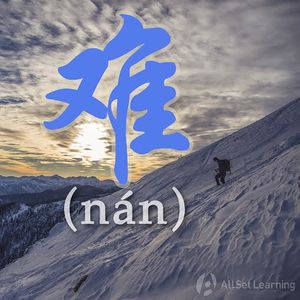Difference between revisions of "Expressing "difficult" with "nan""
(→Books) |
|||
| Line 30: | Line 30: | ||
== Structure with Sensitive Verbs == | == Structure with Sensitive Verbs == | ||
| − | 难 (nán) can also be attached to sensitive verbs ( | + | 难 (nán) can also be attached to sensitive verbs (e.g. look, taste, smell, etc.) to indicate that something is ''bad to do''. The structure is: |
<div class="jiegou"> | <div class="jiegou"> | ||
Revision as of 06:24, 20 June 2013
-
Level
-
Similar to
-
Used for
-
Keywords
Whenever something is "hard to do" (as in difficult) or "bad to do" (as in bad experience), the word 难(nán) can be used.
Contents
Structure with General Verbs
Just as 好 can be used to indicate that it's easy to do something, 难 (nán) can be attached to verbs, except sensitive words, to indicate that something is hard to do. The structure is:
Subject +(很)难 + General Verb
Examples
- 难懂hard to understand
- 这 句 话 很 难懂。This talk is hard to understand.
- 难学hard to learn
- 汉语 很 难学。Mandarin is hard to learn.
- 难做hard to do
- 三明治 很 难做。Sandwiches are hard to make.
- 难买hard to buy (as in probably hard to find)
- 这 个 东西 现在 很 难买。This thing is really hard to purchase now.
Structure with Sensitive Verbs
难 (nán) can also be attached to sensitive verbs (e.g. look, taste, smell, etc.) to indicate that something is bad to do. The structure is:
Subject +(很)难 + Sensitive Verb
Examples
- 难听sounds bad(hard to listen to)
- 这 首 歌 很 难听。This song is terrible. (This song is hard to listen to.)
- 难闻smells bad(it stinks)
- 这 只 小 猫 很 难闻。This little cat smells bad.
- 难看hard to look at (looks bad/ugly)
- 这 件 衣服 很 难看吗?Is this piece of clothing ugly?
- 难吃disgusting (hard to eat)
- 你 做的菜 很 难吃。The dishes you cook taste bad.



